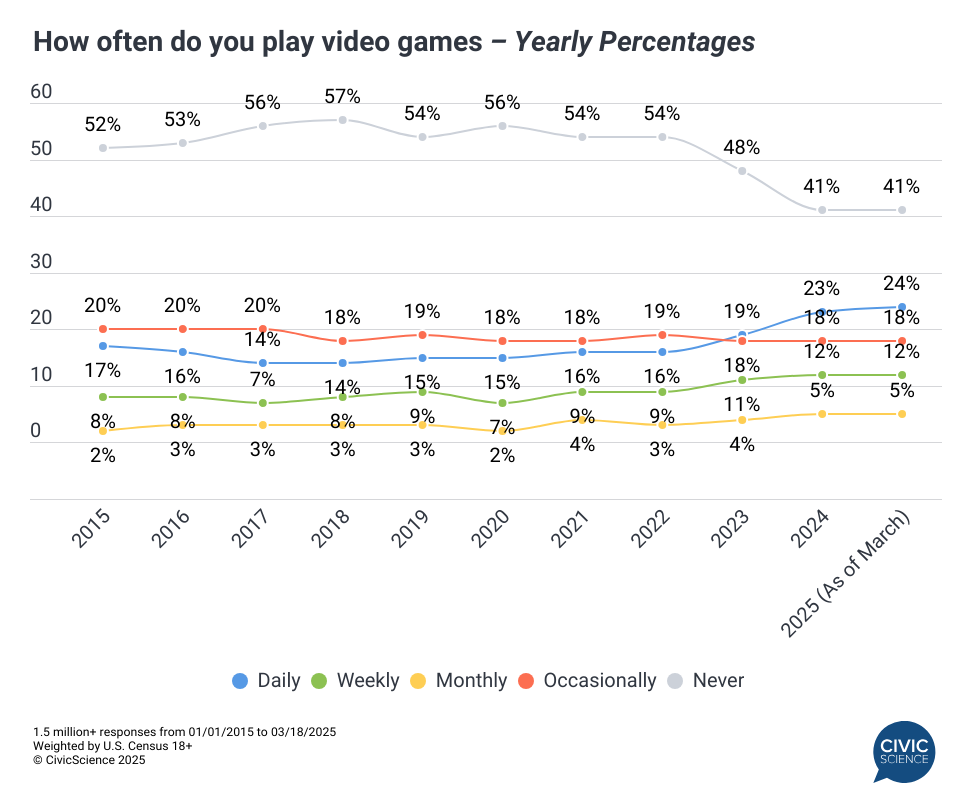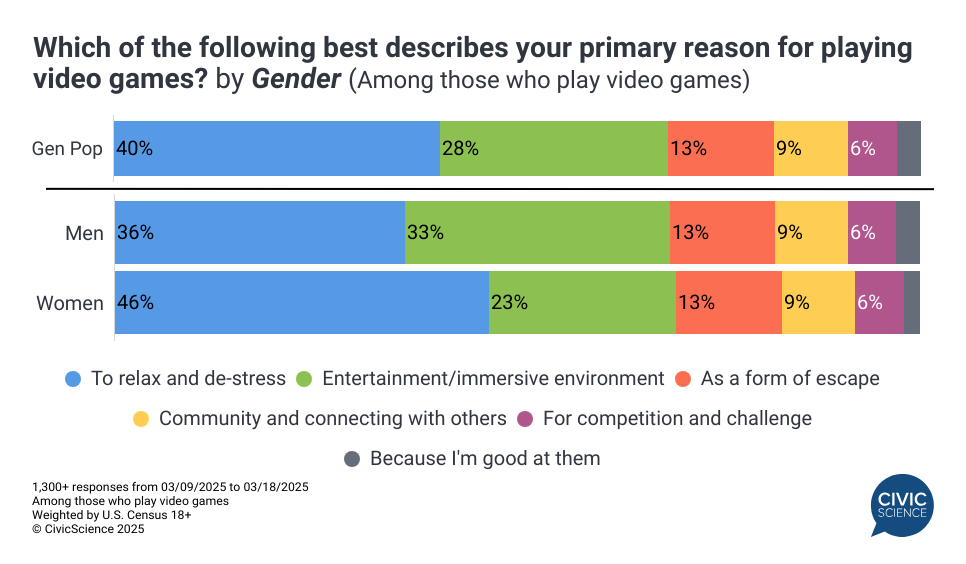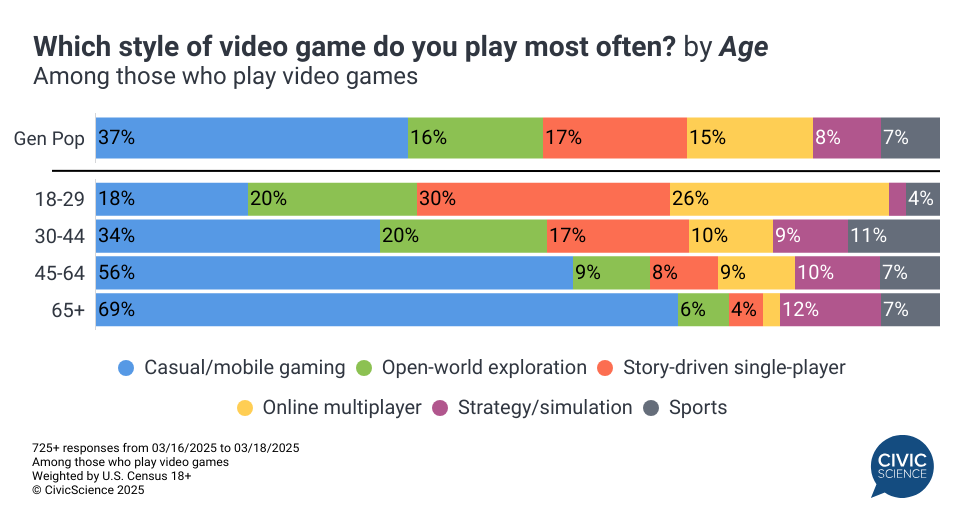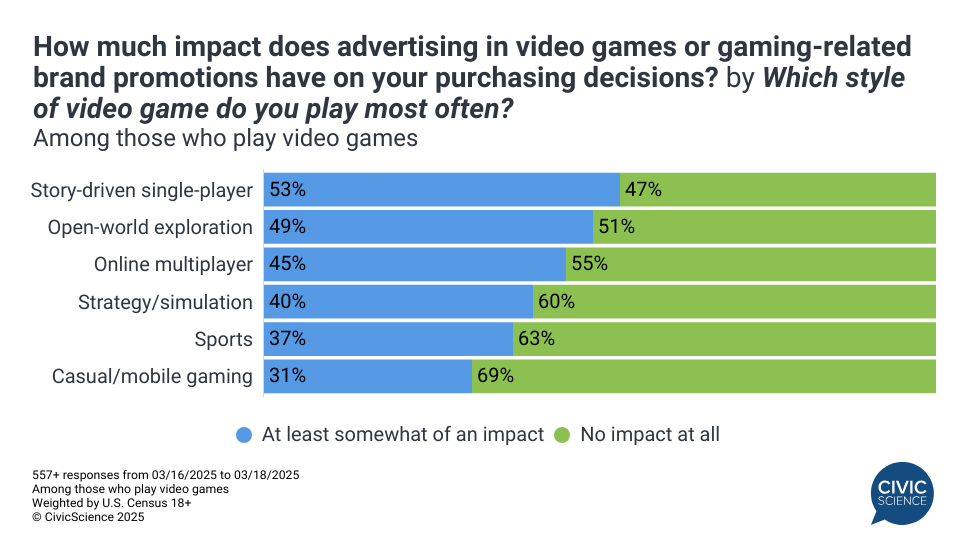This is just a tiny glimpse of the data available to CivicScience clients. Discover more data.
As third spaces dwindle, well-being falls, and fewer Americans feel the urge to go out, video games are increasingly becoming a haven. CivicScience data show gaming remains at record highs – 59% of U.S. adults play at least ‘occasionally,’ matching the highest level since tracking began in 2012. While overall play remains steady from 2024, ‘daily’ gaming has gradually trended up since 2022, including a one percentage point increase from 2024.
Gamers unsurprisingly skew younger – 42% of those aged 45+ report playing video games on occasion, compared to 78% of those under 45. Men and women are nearly equally likely to be gamers, but women hold the slight edge in being daily gamers (24% to 23%, respectively).

Americans Turn to Gaming Unwind and De-stress
What’s driving the high percentage of Americans to turn to video games? Additional data shows that the majority (53%) of Americans who play cite ‘to relax and de-stress’ (40%) or ‘as a form of escape’ (13%) as their primary reason they play video games. These are followed by ‘entertainment/the immersive environment’ (28%), while ‘community and connecting with others’ (9%), ‘competition and challenge’ (6%), and ‘because I’m good at them’ (3%) are much less common motivators.
Data also shows that women are slightly more likely to have increased the amount of time they play per day compared to men (31% to 28%, respectively). Given the sliding overall well-being of Americans, these increases are not surprising to see, particularly as close to half of women gamers (46%) say they play to de-stress alone.

Use this Data: CivicScience clients use data like this to understand the motivations of their customers that may be driving shifts in behavior that could impact retention and growth.
Mobile Gaming Takes the Crown, Especially among Americans Over 45
When it comes to the type of video game, mobile games are the clear leader in terms of the style of video games Americans most often play, largely driven by gamers who are 45+. Open-world exploration and story-driven single-player games follow behind and tend to be most popular for those under 45. Gen Z in particular is fairly split on the type of games they play.

Answer our Poll: Do you play “cozy games” to help you relax and unwind?
Why Gaming Should Be on Brands’ Radar
Video games certainly aren’t a new frontier for advertising, but as CivicScience data show, they are an avenue that brands shouldn’t overlook—as much as 39% of gamers say their purchasing decisions are at least ‘somewhat’ influenced by advertising seen in video games or by video game-related brand promotions. But ‘impact’ can mean in a negative way as well, meaning brands considering jumping into the gaming realm need to ensure they know what resonates with the gamers they want to reach (click here to learn more about how CivicScience can help with that).
Players of certain game types are more responsive to gaming-related ads than others. For example, 53% of story-driven single-player game players and 49% of open-world exploration players are at least somewhat influenced. Online multiplayer games also score higher, likely due to frequent promotions in titles like Call of Duty and Fortnite. In contrast, mobile gamers are among the least responsive, likely due to the oversaturation of in-game ads that can diminish their impact.

Let us Know: Do you personally ‘speedrun’ video games or watch others speedrun games as a hobby?
As video games continue to serve as both a stress-relief outlet and a potential advertising opportunity, brands looking to engage gamers must navigate the space carefully. With varying levels of ad receptivity across gaming genres, understanding player motivations and preferences will be key to making meaningful connections in an increasingly immersive and influential industry.






























